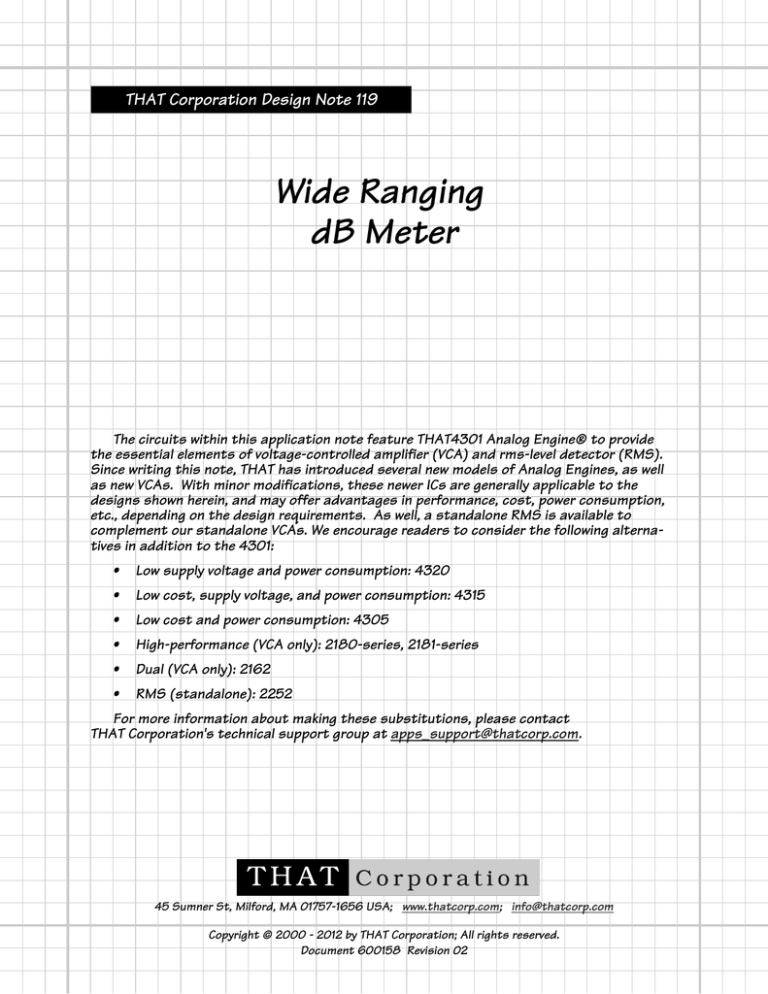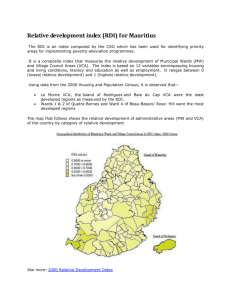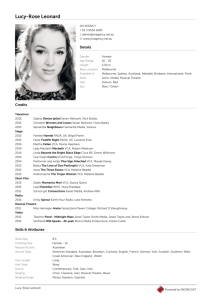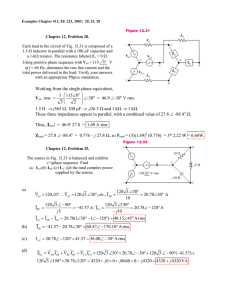
THAT Corporation Design Note 119
Wide Ranging
dB Meter
The circuits within this application note feature THAT4301 Analog Engine® to provide
the essential elements of voltage-controlled amplifier (VCA) and rms-level detector (RMS).
Since writing this note, THAT has introduced several new models of Analog Engines, as well
as new VCAs. With minor modifications, these newer ICs are generally applicable to the
designs shown herein, and may offer advantages in performance, cost, power consumption,
etc., depending on the design requirements. As well, a standalone RMS is available to
complement our standalone VCAs. We encourage readers to consider the following alternatives in addition to the 4301:
•
Low supply voltage and power consumption: 4320
•
Low cost, supply voltage, and power consumption: 4315
•
Low cost and power consumption: 4305
•
High-performance (VCA only): 2180-series, 2181-series
•
Dual (VCA only): 2162
•
RMS (standalone): 2252
For more information about making these substitutions, please contact
THAT Corporation's technical support group at apps_support@thatcorp.com.
45 Sumner St, Milford, MA 01757-1656 USA; www.thatcorp.com; info@thatcorp.com
Copyright © 2000 - 2012 by THAT Corporation; All rights reserved.
Document 600158 Revision 02
Wide Ranging dB Meter
THAT Corporation Design Note 119
Using a THAT4301 as a 2:1 feedback compressor effectively doubles the dynamic range of
the THAT4301's RMS detector by compressing the VCA's 120dB dynamic range through the
80 dB dynamic range of the level detector. This results in a true RMS meter with ~120 dB
dynamic range and an output linear in dB, suitable for all but the most demanding metering
applications.
Basic Topology
Figure 1 shows the basic topology of a feedback compressor. The analysis of this circuit
is not very intuitive in the linear domain, but greatly simplified when working in the log
domain.
Input
(X)
12dB
standby
gain (ks)
VCA
€
+
RMS Out
(G)
VCA Out
(Y)
-
Zero dB reference level (RL)
Figure 1. Signal flow diagram for a feedback compressor
First, let us make a few assumptions and clarifications:
• X is the VCA input, and we will let its full scale be 20 dBu.
• ks is the stand-by gain, independent of the control port, taken in the VCA. We will
set this value at 12 dB.
• Y is the VCA output, measured in dBu, and is also the RMS detector input.
• RL is the zero dB reference level of the RMS detector. This is the input level which
results in zero volts out of the RMS detector, and as a result, sets the VCA current
gain to unity. At the zero dB reference level, the currents in and out of the VCA will
be equal or matched, thus the term level match. We will set this value at -20 dB.
• G is the current gain of the VCA, in dB, as controlled via its control port. It is also a
direct function of the output of the level detector.
Since we are working in the log domain, we can say
Y = X + ks + G
(eqn. 1)
which is the same as multiplying these terms in the linear domain. It is also clear that
G = RL − Y
(eqn. 2)
This sign convention results from our use of the negative control port of the VCA.
Substituting for G,
Y = X + ks − Y + RL,
Copyright © 2000-2012
by THAT Corporation
All rights reserved.
or
Y=
X+ks+RL
2
(eqn. 3)
45 Sumner St, Milford, MA 01757 USA; www.thatcorp.com
Design Note 119
Page 2 of 6
Doc. 600158 Rev. 02
Wide Ranging dB Meter
THAT Corporation Design Note 119
VCA Input in d Bu
VCA O utpu t in dBu
VCA current gain in d B
20
10
0
-10
-2 0
-3 0
- 40
- 50
-6 0
-7 0
-8 0
-9 0
-10 0
6
1
-4
-9
-14
-19
-2 4
- 29
-3 4
-3 9
-44
-4 9
-54
-2 6
-2 1
-16
-11
-6
-1
4
9
14
19
24
29
34
Figure 2. Input and output levels of the VCA for a feedback
compressor, and the VCA current gain
The table in Figure 2 shows the resulting VCA output, calculated with equation 3, and the
resulting VCA gain, calculated with equation 2, that corresponds to the given VCA input
shown in the first column. Note that while the dynamic range of the input is
20-(-100)=120dB, the dynamic range of the VCA output is only 34-(-26)=60dB, thus
demonstrating the 2:1 compressor action. The gain range of +34dB to -26dB is well within
the VCA's preferred operating range.
6
8
In pu t
+1 5V
R8
U1C
OA2 7
43 01 P
S PAR E
5 1R
C3
R 12
17
20 k
22u
F S= 20dB u
C4
22u
R5
1
9 k1
2
IN
R6
2M
IT
15
14
E C+
SY M
O UT
RMS
4
CT 5
43 01 P
4 7p
R1 4
8 0k
12
OA 3
U1 A
43 01 P
11
V+
IN
O UT
13
VGN D
10
E C9
16
-15 V
L eve l m at ch =-20dB u
C 12
C2
10 u
3M9
R9
-1 5V
C6
100 n
R 10
C5
100 n
R3
3 .25m V /d B
5k
+15 V
+3 3 00p p m
C1
V R2
10 u
50 k R 11
-1 5V
1 2dB o f s ta n db y ga in
19
20
6 0k4
4 30 1P
U 1D
OA1 18
O u tp ut
-3 9 .3 m V /d B
0 dB R e f. Trim
4 4 2k
Figure 3. Schematic for a wide ranging RMS level meter
Copyright © 2000-2012
by THAT Corporation
All rights reserved.
45 Sumner St, Milford, MA 01757 USA; www.thatcorp.com
Design Note 119
Page 3 of 6
Doc. 600158 Rev. 02
THAT Corporation Design Note 119
Wide Ranging dB Meter
Application Circuit
The circuit in Figure 3 shows a basic implementation of the wide ranging RMS level meter.
This circuit consists of a VCA with 12dB of stand-by gain, an RMS detector connected to the
VCA in a feedback compressor topology, and a RMS output scaling amplifier. This circuit is
designed to have a full scale input of 20dBu and an output that is scaled to transform a
-100 to 20 dBu into a signal that swings 0-5 V, which is compatible with many low cost 8-bit
ADCs.
The VCA with stand-by gain
This circuit accepts a full scale signal of 20 dBu. If the source is not that high, one can
configure the spare op-amp, U1C, as an amplifier to scale the signal appropriately. In most
applications, log-antilog VCAs are used with zero dB of stand-by gain; that is, when the
difference between the control ports is zero, the total voltage gain is one. In this design it is
beneficial to use stand-by gain to skew the compressor's gain requirements. If not, then the
maximum VCA gain required would be +40 dB when the VCA input dropped to -100 dBu, which
the VCA can provide, but at the expense of bandwidth.
Other VCA issues
C12 helps OA3 maintain stability against the high output capacitance of the VCA. This
capacitor, in conjunction with R14, set the bandwidth at ~56 kHz. Since this is a measurement application, we have not included a means for adjusting the VCA symmetry. The worst
case distortion without trimming symmetry is about 0.7 % THD, and this will not result in a
significant error. C2 should be of value comparable to that of C1. Its purpose is to provide a
path for the peak return currents of C1, which can be quite high.
The RMS detector
THAT Corporations RMS level detectors derive the true RMS level of an audio signal by:
1. Converting the input into a current and full wave rectifying it.
2. Logging and doubling this current waveform, which in the log domain, is equivalent
to squaring.
3. Averaging the result in a log-domain filter, which results in the mean of that signal.
Thus, THAT RMS detectors perform the mean and the square portion of root-meansquare. The square-root portion of that function is performed implicitly at the logarithmic
control port of the VCA.
The two design criteria a designer needs to worry about are the RMS timing and the zero
dB reference level. Timing determines the attack and release rates, which are linked in these
level detectors, and the zero dB reference level determines the input level where the RMS
output will be zero, thus setting the VCA to zero dB of current gain.
Before proceeding, it is useful to enumerate some of the constants in this design:
Vcc = +15V and Vss = -15V
IT = 7.5 μA is the recommended value for IT
k = 6.5 mV/dB is the room temperature gain control constant for the VCA and the
RMS detector.
Copyright © 2000-2012
by THAT Corporation
All rights reserved.
45 Sumner St, Milford, MA 01757 USA; www.thatcorp.com
Design Note 119
Page 4 of 6
Doc. 600158 Rev. 02
Wide Ranging dB Meter
THAT Corporation Design Note 119
Timing
In this design, the timing current is set to the recommended value by R6:
15V
R6 = −Vss
I T = 7.5 A = 2 M
The level detector's log domain filter consists of this capacitor, and a diode internal to
the IC. The equivalent resistance of this diode can be determined by the equation:
1
gM
rd =
VT
Id
rd =
=
VT
Id
Thus,
{ 3.499k , at 27ºC
If we set the corner frequency to f c { 5 Hz ,
which is an adequate low frequency corner for most audio signals, we may then calculate
the time constant
$=
1
2 % % fc
=
1
2 % 5Hz
{ 32 ms
Using these identities, we can calculate C1:
C1 =
rd
$
=
32 ms
3.466 k
= 9.2 F = 10 F
Zero dB reference level
The zero dB reference level is set by the input resistor of the RMS detector, and the
detector's zero dB input current. To set this level, one must first determine the zero dB
input current.
I ZERO dB = 9.6 A % I T = 9.6 A % 7.5 A
which results in I ZERO dB = 8.5 A
As stated earlier, we chose -20dBu as the zero dB reference level. This corresponds to:
V ZERO dB = 0.775 % 10
−20dBu
20
= 77.5 mV
Using this value, we can calculate the appropriate value for R5:
R5 =
VZERO dB
IZERO dB
=
77.5 mV
8.5 A
{ 9.1 k
Output buffering and scaling
The gain control constant for the THAT4301 is 6.5mV/dB, but due to the 2:1 compressor
action, the change at the output of the RMS detector is only 3.25mV/dB. This voltage is
also proportional to absolute temperature. As a result, it is often useful to apply scaling
and temperature compensation to this signal.
There is a wide variety of 8 bit DACs available today, some with a per channel cost below
$0.35. In their simplest configuration, these devices operate off +5V, and use a filtered
version of their supply as their reference voltage. If one wishes to measure the wide ranging
meter's output to within ±½dB, the RMS detector's output needs to be scaled to
5V
256 bits
%
2 bits
dB
Copyright © 2000-2012
by THAT Corporation
All rights reserved.
V
= 0.039 dB
45 Sumner St, Milford, MA 01757 USA; www.thatcorp.com
Design Note 119
Page 5 of 6
Doc. 600158 Rev. 02
THAT Corporation Design Note 119
Wide Ranging dB Meter
In this design, OA1 is configured as an inverting summing amplifier. R3 should be a
+3300 ppm/ºC resistor, as this will correctly compensate the temperature coefficient of
the level detector's gain control constant (the temperature coefficient of the VCA's gain
control constant is compensated for by the RMS detector, and as such, this correction
should be made after the connection to the control port). We have chosen a 5 k Ω resistor
for R3, since this value is readily available from KOA Speer and can be driven by the output
of the RMS detector.
AV =
5V
120dB % 3.25 mV
dB
= 12.8
Thus, R10 = 12.8 % 5 k = 64.9 k
(Note: For simplicity, we have failed to show the sign of the gain, since this can easily be
accommodated once the signal is converted into binary form. It does mean that zero volts
corresponds to 20 dBu, and -100 dBu is near 5V. If this becomes an issue, OA2 can be used
to invert the polarity.)
The 5 kΩ resistor implies that in the summing node, the current that represents one dB
will be:
i 1 dB =
0.00325 mV
dB
5 k
= 0.65
A
dB
We can use the results of the equation above to calculate a zero offset that will make
-100 dBu-to-20 dBu proportional to 5V-to-0V. As stated previously, the zero dB reference
level point is at -20 dBu at the RMS, but there is also 12 dB of voltage gain in the VCA, and
the zero dB reference level relative to the VCA's input is -20 dBu -12 dB = -32 dBu. When
you account for the 20 dBu full scale, the output of the RMS detector is positive for 52 dB
above zero dB reference level, and this will result in a corresponding negative excursion of
OA1. R9 is used to provide an offset that will eliminate this excursion:
R9 =
15V
52 dB %
0.65A
dB
{ 443 k
R11 provides ±6 dB of adjustment, to accommodate the ±3dB tolerance on the zero dB
reference level of the THAT4301, and for other component and power supply tolerances.
R11 =
15V
6 dB %
0.65A
dB
{ 3.9 M
Conclusion
Using the THAT4301 as a wide ranging meter provides a simple and convenient way to
convert audio signals with up to a 120 dB dynamic range into a high level signal that can be
read with ½dB resolution by an inexpensive, 8-bit DAC.
Copyright © 2000-2012
by THAT Corporation
All rights reserved.
45 Sumner St, Milford, MA 01757 USA; www.thatcorp.com
Design Note 119
Page 6 of 6
Doc. 600158 Rev. 02




